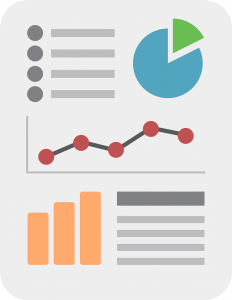
6 minute read:
Simple Steps to Building a Budget for your Business
For companies with a March year end, we are now into a new financial year (as well as tax year). As such It is a good time to think about budgeting. To consider the plan for the next 12 months in terms of the opportunities, threats and approach to achieving business goals for the coming year.
With the impact that Covid 19 is having on business it is ever more important to consider the expected business performance in light of the current conditions and to tailor the budget plans accordingly. This will help you to quantify new routes to market, alternative revenue streams and any areas for cost-saving.
To support you with the budgeting process we have set out some simple steps to help you build a budget.
What is a budget for?
Before we look at the steps to budgeting…. let’s first consider what a budget is for.
Budgeting refers to a plan for your future financial performance. Typically it is how you get to that annual prediction or target for business revenue/profit.
A budget enables you plan, devise and convey how you will achieve goals you’re your management team, budget holders.
At a high level you can share it with your employees so there is a business wide focus and understanding of what good looks like and where the focus should be.
What is involved?
The process of building a budget is typically based on analysing current performance, looking back at how the business has performed over the last 12 months as well as looking at the results of the last few years.
You do this to understand the rates of growth, establish any trends and to establish the usual run rates for costs and margins.
It is also about look forward. Thinking about current market trends, economic factors, inflation rates and new market opportunities as well as changes in relation to threats.

Budgeting step by step
It’s good to approach this in terms of a Profit and Loss format. Starting from the top with Sales and working your way down to build up the Cost of Sales section and Overheads through to Profit.
1. Sales and Commercial Plan
It’s good to start by looking at your commercial plans. How much of what product or service will you sell each month in the next 12 months?
Think about seasonal variations – what happens to your sales at different months of the year, what is the impact of holiday times?
Here it is a good idea to look back at the last few years of trading. What trends can you see in the data? For example can you see there is clear seasonal variations in demand for your products/services?
Has there been a steady increase in the overall sales and price year on year? Looking at the trends and pattern of growth in sales will help you come up with a realistic plan.
Consider the changing market for your product or service going forward. You could look at industry trends, your own observations and economic forecasts.
Consider whether you will be applying price increases in line with inflation or are there other market factors that affect your pricing strategy?
Multiply the unit cost of each products/services you plan to sell in each month by the expected number of sales for that month to get a picture if the sales plan for the year.
2. Cost of Sales
Once you have a sales plan you need to then think about how much it is going to cost to deliver on this level of revenue.
When we talk about Cost of Sales we are looking at things like materials, packaging, productive labour – the costs directly incurred in making and delivering that product or service to the end user.
To ensure your plan for Cost of Sales is accurate, it is worth considering the marginal cost of selling one unit. For example, if you sell one unit for £1000 you know it costs £350 in materials, £300 in labour. So you could times the number of units by the unit cost of materials and labour incurred to ensure you have covered the costs for each product line.
Don’t forget to include at least inflationary increases in the costs of these supplies, in ‘normal times’ adding 2% could be a prudent estimate if you don’t know the exact increases expected from suppliers.
You can also look at the trend in gross margin over the past few years to help you budget the cost of sales effectively. This is the Gross Profit (Sales less Cost of Sales) divided by Sales.
3. Overheads
Overheads includes all the expenses that are incurred, regardless of how many units you sell, in order to run the business. Overheads includes things like rent, admin staff wages, marketing, IT expenses.
To create a budget for overhead take a look at your trend over time, how much did you incur on expenses in these categories over the past few years?
Here you have an opportunity to challenge the spend, you could seek to automate some task to save yourself some staff and printing expenses.
However, is it important to ensure some overhead costs are in line with changes in the commercial plan, for example if you intend to increase revenue by 30% you might reasonably budget a proportionate increase in marketing expenses in that period in order to achieve this increase in customers.
Once you have completed the overheads section, in simple terms you can now do Sales less Cost of Sales (Gross profit) less Overheads to get to your Profit.

Top tips for Budgeting Success
Involve budget holders and senior managers
It is important to get the engagement of your workforce behind the plans for the next year. So why not involve the people responsible for managing the budget and for delivering the targets in the process.
It could be that you give them a blank template to complete for their section of the budget. Everyone brings this along to a collaborative budget meeting where you piece together the budget and collectively challenge and build it to an agreed result.
Where you involve others, people will feel included and empowered and are more likely to commit to achieving the budget results through the year.
They will also have valuable insight into their areas of the business, in terms of the expected costs, trends, opportunities and things you might not have thought about.
Be Accurate on the People Costs
Staff costs will likely fall within both cost of sales and overhead expenses. Where productive employees are a Cost of Sale, involved in manufacture, sales, service delivery. Whereas, admin staff, general management, accounts and HR would fall under overheads.
In budgeting the people costs it is a good idea to make a detailed plan of payroll costs per head and by department (at least a split between cost of sales and overhead). You need to include their salary (plus any expected pay rises), employer NI contribution, pension costs (and any changes to this in the next year), and the cost of any benefits provided, such as company cars.
You should consider existing staff that you will retain in the next year. Plus costs of additional staff you expect to hire during the year. Also, factor in any expected costs of any training and development and the costs of any restructuring activities and recruitment processes.
Scenario Plan
Once you have designed your budget. Create some different scenarios to explore what would happen to the overall picture should revenue fall or increase by say 10%. Make the volume adjustments to cost of sales in line with the scenario.
This will help you to understand the decisions that need to be made should the next 12 months exceed the plans – whereby you might need to hire more people and buy in more materials.
Or if there was an underperformance, you would need to think about where you could reduce costs or at least ensure cost of sales could fall in line with the drop in revenue.

Covid 19 Response
It goes without saying that we are in uncertain times. So in light of the ongoing crisis a few further pointers to think about how current events will affect your business in the next 12 months.
You should factor in new routes to market – setting up an online shop to reach consumers directly.
Perhaps you have taken out a business loan? Remember there will be outgoings for loan repayments.
If you have now found the majority of your work force is working from home. Think about how this might continue, what impact will this have for your need for office space now and in the future as you grow?
That concludes are simple steps to building a budget for your business.
Please feel free to reach out with any questions!
Look out for our up-coming blogs on forecasting and planning capital spend as we continue in the series.
Get in touch today to discuss your needs!
